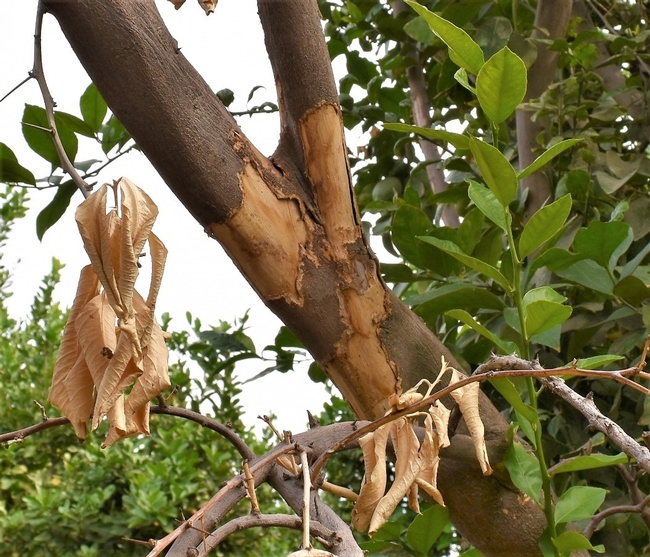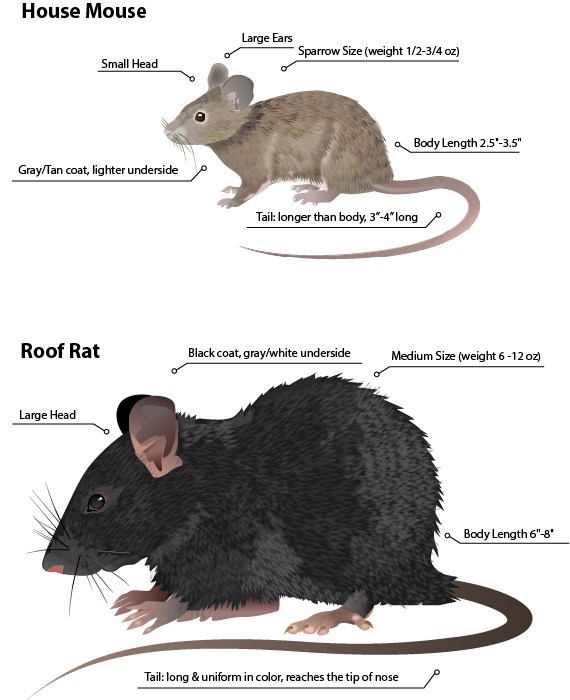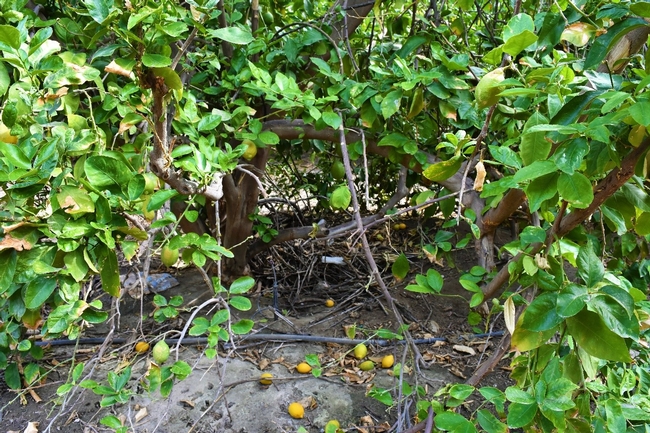
Posts Tagged: rat
What a Mess: Roof Rats in Orchards
The roof rat (Rattus rattus, a.k.a. citrus rat, fruit rat, black rat, or gray rat) is an introduced species of rat native to southern Asia. It was brought to America on the first ships to reach the New World and has spread around the world. This rat is the same species that carried the bubonic plague around the world and is also the reservoir host for murine typhus.
The roof rat is a common vertebrate pest in citrus and nut orchards. In citrus, it builds leaf and twig nests in trees or it can nest in debris piles, thick mulch on the ground, or in shallow burrows under the tree, especially in hot weather. In nut orchards, roof rats often nest around the base of trees. In livestock feed yards and barns, roof rats often burrow under feed bunks or into hay bales. Adult roof rats are 12-14 inches long (30-36cm) and weigh 5-10oz. (150-250g). The sleek rat has a pointed muzzle and hairless scale-covered tail that is longer than the body and head combined. They are the most active at night.
DAMAGE
Rats gnaw on electrical wires, wooden structures, and fruit and nuts on trees. They can also girdle limbs or stems, leading to mortality to part or all of a tree. Roof rats often feed on citrus, avocados, and other fruits, sometimes leaving hollow fruit skins hanging on the tree. After harvest, they damage fruit and nuts in bins by chewing them and leaving excrement. Rats are active throughout the year, and mostly at night.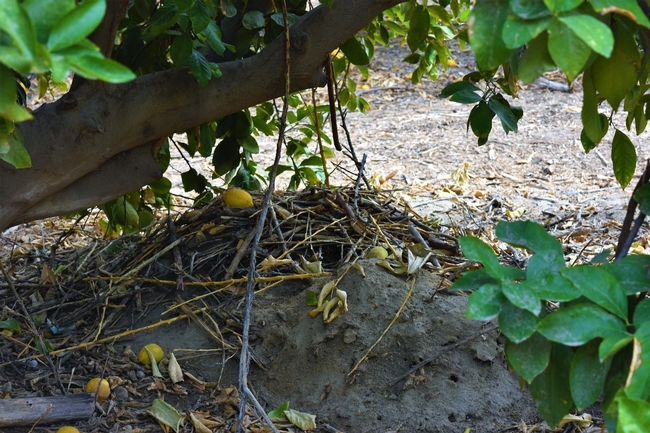
MANAGEMENT
Cultural Control
Because roof rats are such good climbers and swimmers it is hard to completely exclude them from your grove or orchard.
Your fruit trees should be isolated, not touching fences, overhead wires, or the branches of other trees. Roof rats will run along fence stringer boards or support poles, phone and cable TV wires, and tree branches to reach your fruit tree. Lower branches of the tree should not touch the ground. A low-hanging skirt of drooping branches give the rats additional access routes and provides them with protective cover while feeding. Prune tree skirts so that the ground under them is open and visible. This lack of cover makes the rats uncomfortable and more susceptible to predators.
Sanitation is also important. Use or remove all fallen fruit. Reduce shelter and nesting sites of rats. Eliminate debris and woodpiles. Store materials neatly off the ground. Thin and separate non-crop vegetation around orchards where feasible and remove dead wood from fruit trees, especially citrus and avocado.
Monitoring and Treatment Decisions
Baiting *Be sure to identify the species of rat present to avoid killing nontarget or protected species.*
The use of elevated bait stations containing 0.005% diphacinone*-treated oats (sold at some county agricultural commissioner's offices) is highly effective at controlling roof rats in orchards. Secure bait in a bait station before placing in trees on limbs 6 feet or more above the ground. Placing the bait in a secure bait station will prevent bait from dropping to the ground and creating a hazard. Bait stations should also prevent nontarget animals from feeding on the bait. Bait can only be applied during the non-bearing season, so growers must take a proactive approach to managing problematic rat populations.
Trapping
Rat-sized snap or wooden box traps placed in trees are also effective, although a more time-consuming control option. Do not use glue board traps outdoors, as birds, lizards, and other nontarget wildlife may be trapped. Rats are wary, tending to avoid baits and traps for at least a few days after their initial placement. Fasten traps to limbs and bait them with sweet fruit or nut meats, but do not set the traps until after bait is readily eaten.
Be aware that certain types of rat baits for use inside buildings are not labeled for use outdoors in orchards; these are hazardous to wildlife and should not be used.
Rats in Your Orchard
The roof rat (Rattus rattus), sometimes called the black rat, is a common vertebrate pest in citrus, avocado and other yummy tree orchards. It builds leaf and twig nests in fruit trees or nearby trees, or it can nest in debris piles or thick mulch on the ground. This agile, sleek rat has a pointed muzzle, and a tail that is longer than the body and head combined.
Be sure to identify the species of rat present to avoid killing nontarget or protected species. Be aware that endangered native kangaroo rats (Dipodomys spp.) and the riparian woodrat (Neotoma fuscipes riparia) resemble pest rats, but are protected by law. Unlike the hairless, scale-covered tail of roof rats, the tails of kangaroo rats and the riparian woodrat are covered with fur. The riparian woodrat is active mostly during the day, and its tail is somewhat shorter than the combined length of its body and head. A kangaroo rat's tail is noticeably longer than its body and head combined. Kangaroo rats are nocturnal, but unlike Norway rats and roof rats, which move on all four legs, kangaroo rats hold their front legs off the ground and travel by hopping on their hind legs.
Rats gnaw on electrical wires, wooden structures, and fruit on trees. After harvest, they damage fruit in bins, chewing on the bins and leaving excrement. Rats are active throughout the year, and mostly at night.
To help manage rats, reduce shelter and nesting sites of rats. Eliminate debris and wood piles. Store materials neatly and off the ground. Thin and separate non-crop vegetation around orchards where feasible. Exclude rats from nearby structures by properly sealing entry ways.
Baits and rat-sized snap traps placed in trees are the most effective control measures. Rats are wary, tending to avoid baits and traps for at least a few days after their initial placement. Fasten traps to limbs and bait them with sweet fruit or nut meats, but do not set the traps until after bait is readily eaten. Secure anticoagulant wax blocks in a bait station before placing in trees on limbs 6 feet or more above the ground. Placing the wax blocks in a bait station will prevent chunks of the anticoagulant wax from dropping to the ground and creating a hazard.
Be aware that certain types of single-dose rat baits for use inside buildings are not labeled for use outdoors in orchards; these are hazardous to wildlife and should not be used.
For more on the subject see:
http://icwdm.org/handbook/allPDF/RO_B125.PDF
http://www.ipm.ucdavis.edu/PMG/PESTNOTES/pn74106.html
and another blog:
//ucanr.edu/blogs/blogcore/postdetail.cfm?postnum=16880
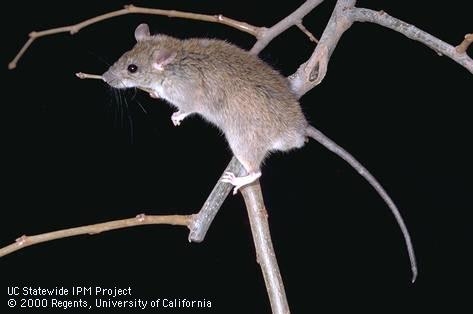
roof rat
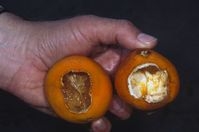
rat damage to citrus
An Unusual Spring
We had a pretty mild winter, in spite of the freeze damage that occurred in the Central Valley. Now we are seeing what happens when there's not enough chilling to break bud. There is erratic flowering and leaf out. This can be quite pronounced in such trees as peach and apricots, apples and pears. There can be well developed fruit, flowers and a leaf flush all occurring at the same time. We select low chill varieties when we know the climate where we live won't regularly get a certain amount of cold sufficient to cause an even bloom. But sometimes it just doesn't get cold enough for a long enough period. Even 'Hass' avocado requires about 50 hours below 45 deg to properly leaf out. This is happening to some of our native trees as well, such as sycamore
Below is a photo of a confused peach taken by Lynn Wunderlich

uneven peach bloom
Rattus rattus
In a mandarin orchard today, I saw what appeared to be sun burn damage. The bark was missing on the top, south facing branches. It was old damage and was healing over along the edges. I mentioned it to the grower who told me it was roof rat damage. Several years prior when we had had a long dry winter, the rats had come out of the hills and were eating his fruit, as well as feeding on the cambium. I've seen this damage in trees near the edges of wild country, as well as along stream and river beds. At one orchard in Santa Paula, the feeding had actually spread Phytophthora in the canopy of lemon trees. For control measures go to:
http://www.ipm.ucdavis.edu/PMG/r107600711.html

IMG 1600

